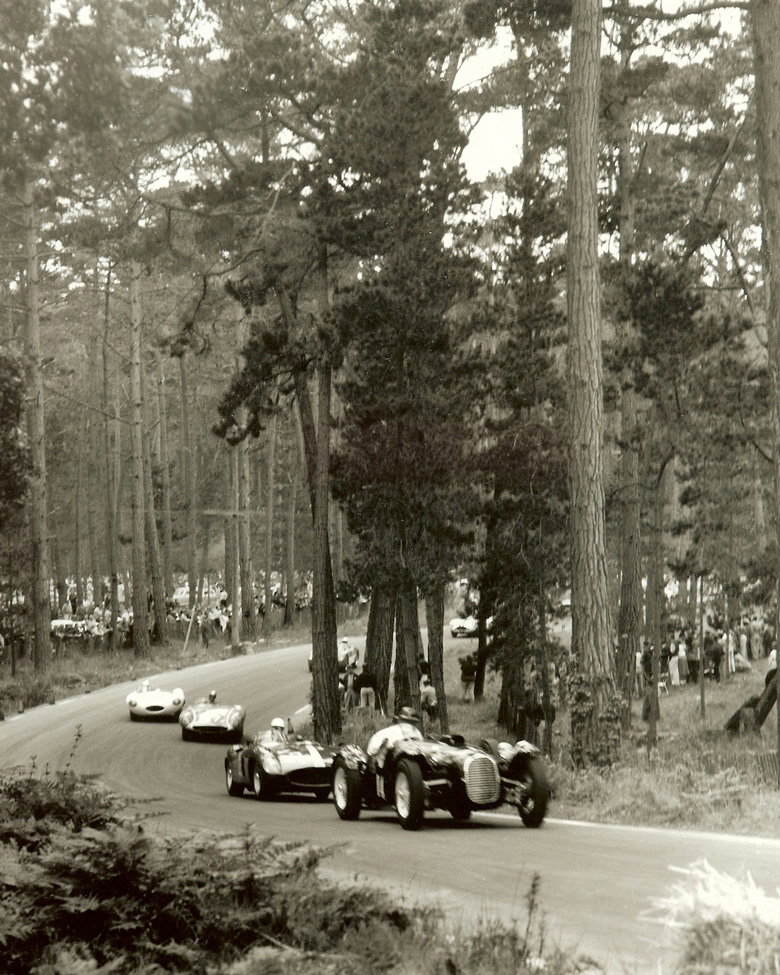
Pebble Beach, 1956. Bill Pollack in the Stovebolt Chevy HWM leads Phil Hill in a Ferrari 860, Ernie McAfee in a Ferrari 121LM, then the Jag D-Type of Pierce Woods, Bill Murphy’s Kurtis 500X, and the Aston of Jack Graham. Photo by Jim Sitz.
West Coast racer Bill Pollack passed away at the age of 92 on July 16. Our thanks to Jim Sitz, Michael Lynch, Allen Kuhn, William Edgar and Willem Oosthoek for their help with this article.
Appreciation by Jim Sitz
The late Bill Pollack was a real pioneer in sports car racing. After his discharge from the Army Air Force in 1945, the handsome young man just had to have a new MG TC in British Racing Green. And so began a great racing career.
Although I had seen him in competition in the early days of Pebble Beach and Palm Springs, I would not have the good fortune to know him as a fine person until years later when he and Art Evans formed the “Fabulous Fifties” group. Many enthusiast remember an even younger Phil Hill in those halcyon times but not many realize that Hill’s main competition was Wild Bill Pollack!
Their duels were indeed wild, through the woods of Pebble Beach, round the Golden Gate Park of San Francisco or in the streets of Reno, Nevada. I had the pleasure to see them going at it, Pollack had the upper hand in the Allard-Cadillac, while Phil would struggle to keep up in the Jaguar XK-120 and C-Type, or his own Ferrari 212.
Bill had never considered going professional since he had Bobbi, his loving wife, and several children. The closest he came to going pro was running at Sebring 1957 in the Reventlow Maserati 200 SI. Years later when I got to know him on friendly basis, I inquired just how he got that nice ride. He laughed and commented how Lance was a friend and would drive all way over from Beverly Hills to their home in the San Fernando Valley and then, actually cook dinner for him and Bobbi!
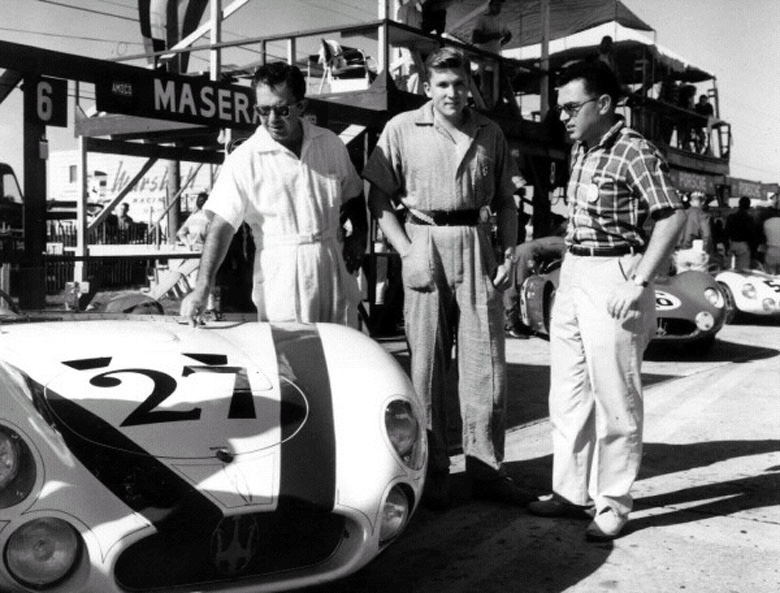
Bill on the left, next to Lance Reventlow and with Lance’s Maserati 200SI, chassis 2405. Credit: Willem Oosthoek Collection
Obviously he had the talent to go big time, but chose not to. He was known for his dry wit and kindness to friends in distress, and I knew that from being one of them. He was a real straight shooter, as I found out in 1992 while doing research for Vintage Motorsport and trying to confirm if the story was true that he had tested the new Scarab for Lance Reventlow.
But he laughed and told me, “Wish it was, Jim, but that was Chuck Daigh instead.” Bill could have claimed anything then, but he was such an honest man he couldn’t help tell the truth.
Appreciation by Michael T. Lynch
Bill Pollack, one of the pioneers of Western road racing, has left us and we are poorer for it. He ran his MG TC in the first Southern California road race, Palm Springs in April 1950. He performed so well that he was next seen in John Edgar’s supercharged MG Special at Santa Ana in June and closed his season with a win in the same car at Carrell Speedway in October.
The beginning of his rise to the top took place in a Los Angeles Jaguar dealership in 1950. Tom Carstens, was a meat packer from Tacoma with a background in outboard boat racing and as an entrant of a successful midget. His hot dogs were served at many of the tracks where his car competed.
At the Jaguar showroom, he appeared in white pants and shirt, causing the sartorially proper salesmen to ignore him. What they didn’t know was that those white work pants contained $10,000 in cash and he was planning on buying two Jaguar XK-120s for himself and a friend. After no attempts by either of the salesmen on the floor to engage him, he left. Instead, he bought two Allard J2s. He got his fishing buddy, Ed Iskenderian, the speed equipment manufacturer, to build him a full race Cadillac engine for his Allard.
In the meantime, Bill Pollack had heard of the project and called Carstens. Carstens asked about his experience and Bill said he had had a ride in an Allard, which was true, but he wasn’t driving it. Carstens engaged Bill to race his car.
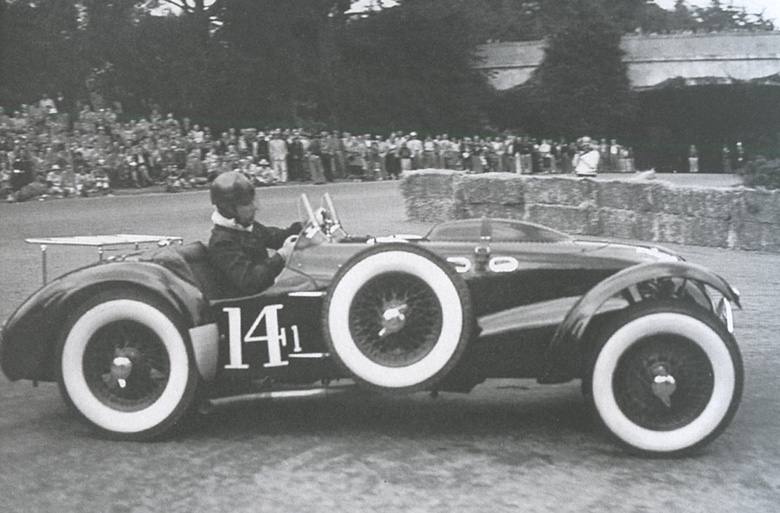
Golden Gate Park, May 31, 1952. The big Allard with Pollack driving took yet another win, this time getting the best of Phil Hill in a Ferrari 212. Bill Pollack Collection
With four races behind him, Bill showed up at the West’s biggest race, Pebble Beach in 1951, where the car was waiting for him at the gas station in Carmel. He and a mechanic proceeded down Highway One toward Big Sur. When he punched it on an uphill lefthander, the brisk onshore breeze reversed itself and Bill had to back off to keep the car on the two lane road. To the right was a long drop to the Pacific.
The next day, Bill got the feel of the Allard in the Pebble Beach Handicap, finishing fifth. In the main Pebble Beach Cup, he walked away with the race. That was followed by a win at Reno, where Carstens also used the car to win the novice race.
The 1952 Pebble Beach race was a repeat of the previous year only now the car was spectacular in its appearance. Always sanitary, it now had its disc wheels replace by red wire wheels with whitewall tires. They included a side-mounted spare. It also sported a luggage rack on the rear deck and the grille was in place with a badge bar in front, complete with SCCA and Allard Owners Club badges. More victories followed at Golden Gate and Madera where Bill held off Phil Hill in a Ferrari and a C-Type Jaguar respectively.
These victories made Bill and the Allard the first big stars of Western road racing, along with future World Champion Phil Hill, who had hounded the Allard several times. Phil finally had his day at Pebble in 1953 when his and Bill Spear’s Ferraris relegated Pollack and the Allard to third place. In an event worthy of Grand Opera, the Allard, perhaps smarting from its loss, crashed after the race and never raced again until it had a vintage career.
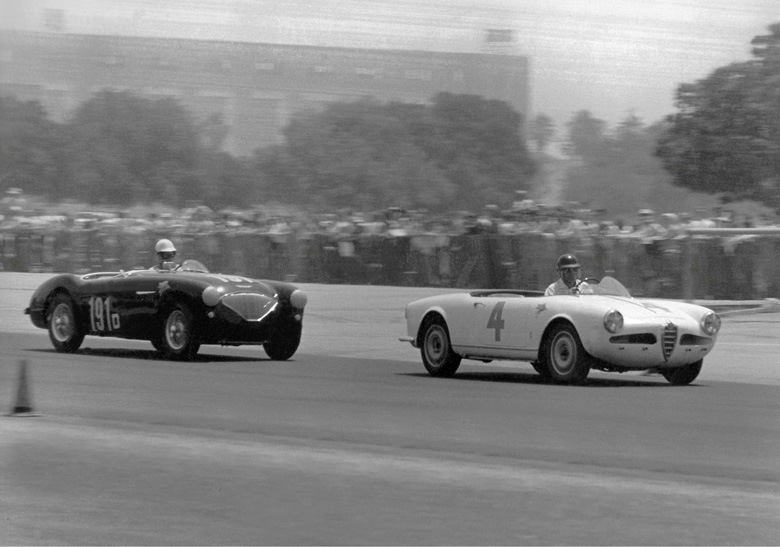
At Pomona on June 24 1956, Bill drove his Alfa to a second in Class F and third over all. Robert Wilson was the other player in the Healey and finished first in Class D and thirteenth over all. Photo credit Allen R Kuhn.
Bill continued to race through 1958, winning in cars as varied as a Corvette, Alfa Giulietta and the Baldwin MkII Special. He also gave back to the sport by serving countless hours on the board of the California Sports Car Club.
Bill never lost interest in the sport he loved and he, Phil Hill and Art Evans preserved the camaraderie of the era by starting a non-organization with non-members called the Fabulous Fifties Sports Car Club. It was open to all and allowed enthusiasts of all generations to mingle with the heroes of another age.
They better stand back at the entry to Heaven’s Gate. The blowback from those Allard side pipes can cause havoc with angel wings.
Appreciation by Pete Vack
In 2002, Bill Pollack approached us about publishing his autobiography. A bit late, we said, as we had just sold the VelocePress business, but we’d be happy to edit the manuscript and find a publisher for him.
And thus began a very enjoyable and privileged relationship, and one of my most memorable and meaningful experiences as a writer/editor.
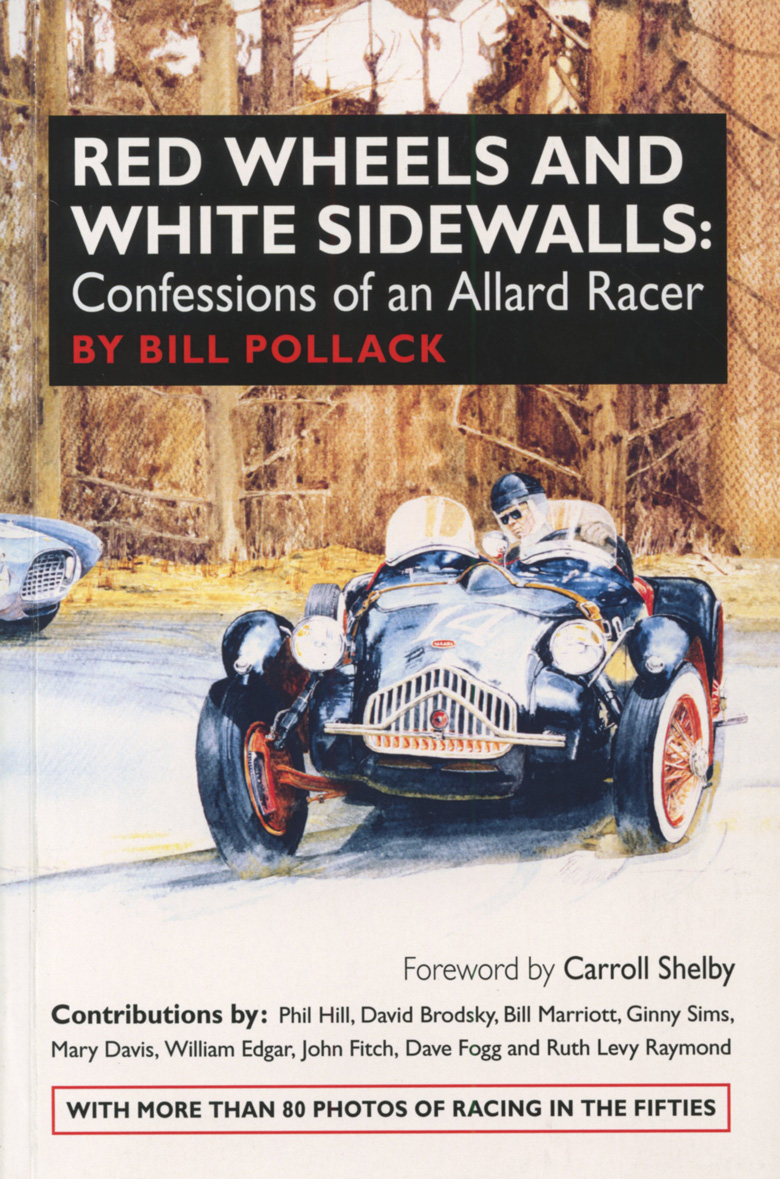
Editing Bill was one thing, finding the right title was another. The cover art for Bill Pollack’s autobiography was a water color painting of the famous Allard by Charles W. Queener. Click on image to order book.
A few things soon struck me about Bill after taking a look at the manuscript. He could tell a great story. Bill wrote about being born into a show business family, and that in the year 1925, Eddie Cantor (one of the biggest name in show business at the time) came to see what Lew Pollack’s new baby Bill looked like. Apparently young Bill looked like he had been out in the sun too long, with a face like a dried apple and long hair. Bill claims to have heard the famous comedian remark to his father with those huge, sad eyes, “Gee Lew, I’m sorry.”
Not only could Pollack tell a good story, but he had more stories than anyone has a right to. After surviving Cantor, Shirley Temple was a childhood friend, though Temple’s mother did not approve of Bill and his antics. And in telling his stories, he wrote in a unique style that while at times could be repetitious, was never boring. Do not, under any circumstances, I told myself, bend, fold or mutilate his writing style.
He was modest and took things for granted that others would find astonishing. One day he offhandedly mentioned that he went to high school with Norma Jeane Baker, later known as Marilyn Monroe. But there was no mention of this in his manuscript. I remember asking, “Well Bill, don’t you think your readers might like to hear about that?” He then added quite a bit more about famous people in his chapter “Just Plain Folks”.
He was bright. At the age of 77 and of a decidedly analog generation, Bill decided to switch from MS DOS to Apple in the middle of sending me hundreds of Word Docs. I know of many smart folks that even today would boggle at the thought. Bill did it almost overnight and never missed a page. I was impressed.
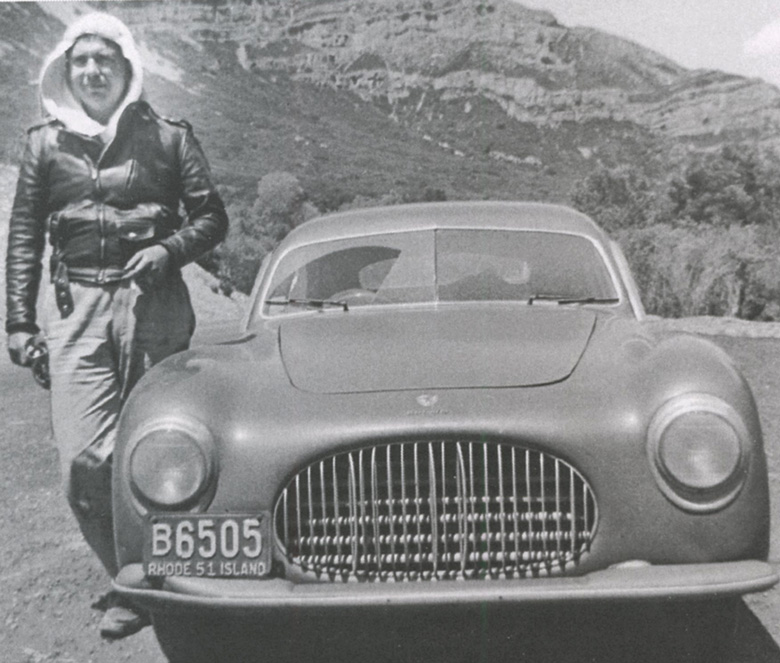
Pollack worked for Petersen Publishing for a few years. Pete Petersen purchased a Cisitalia on the east coast and had Pollack take the train to Rhode Island to pick it up. He then drove across the U.S. in the car, with a blown head gasket the entire way. Bill Pollack Collection
As a youth, he was a hellion, an out of control son whose daring-do kept getting him into trouble. “Long before I ever set my tail behind a steering wheel, there were signs that would have tipped off an astute observer that this kid needs careful watching.” It was the first sentence of the first chapter, entitled “Three Falls From Grace, or, Early Signs of Automotive Insanity”. After reading that chapter, one might have also said to his father, “Gee Lew, I’m sorry.” But living on the edge of juvenile delinquency is how many competitive race drivers come to be both competitive and driven. Bill was both.
Organizing the reams of material Bill would send electronically was difficult as there were so many topics which defied easy classification. We adopted a method of inserting the comments made from a wide variety of people including Bill Marriott, Phil Hill, John Fitch, William Edgar and Ginny Sims, calling their contributions ‘Other Voices’. We got Carroll Shelby to write the Foreword. And we broke up the life of Bill into five parts, none of which was in any kind of chronological order. But it was Bill.
That was easy compared to figuring out what to call the book. Against all odds, despite being brilliant, creative, funny and a thoroughly original person, Bill wanted to name it “The Auto-Biography of an Allard Racer.” He surely could do better than that. Throughout the year or so, we came up with several other titles, but none a good fit. I asked him, what was his favorite driver autobiography? We discussed “Touch Wood” by Duncan Hamilton, “Challenge Me the Race” by Mike Hawthorn, titles one does not forget. And finally, just as the manuscript was ready for the publisher, we had it. I remembered how striking the Cartsens’ Allard appeared, and everyone knew it was Pollack behind the wheel and never forgot the looks because it had red wheels and whitesidewalls. And there was our title.
Bill was elated. Not I though, for I knew we’d come to the end of our wonderful journey together.
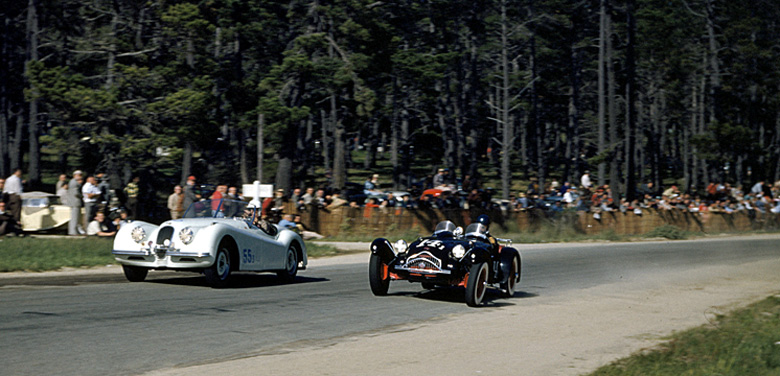
Pebble Beach 1952. Bill Pollack is about to win first overall in the most famous Cad-Allard of West-Coast sports car racing – here he’s about to pass Sam Weiss in the XK-120. The cars have just turned onto the main or pit straight and are coming out of a slight left hand bend. From here it is full throttle for a moment or two and then a very high speed bend just past the pits and a hard stop for a 90° right hand turn. Credit corsa@corsaresearch.com
Last week we published a tribute to the late Bill Pollack, and following that we received more interesting photos and comments, which deserve to be published as well. Ergo, here is a bit more about Bill Pollack with some rare images. But first, a few comments from our readers:
Another great one bites the dust.
–Ed Gilbertson
Well done all, on a subject of one of greats of all time.
–Bob Devlin
A great feature on a driver that I used to read about in the U.K. magazines of the early 1950s. Quite a character. Nice to see the picture of Bill with Lance Reventlow, who was a very nice young man who I spoke to at Crystal Palace in 1957.
–Eric Dunsdon
Nice article on Bill. Bill did 49 video interviews with car people starting in 2001. I helped Bill on the project from 2009 until the last one with Dan Gurney in 2012. Most done at the Petersen museum.
–Bob Schmitt
Bill Pollack agreed to be in my book “They Started in MGs.” In addition to his many other attributes, Bill wrote and spoke in a very colorful, very interesting way. Commenting on The Maestro’s test drive of the Corvette “Mule” at the 1957 Sebring, he said of Fangio “He had just set the lap record in the Maserati. He got into the car and took off out of the pits like a rocket. He did the first lap so fast that the suits from GM couldn’t believe their stopwatches. He set a time that was 2 or 3 tenths off the record. He got out of the car, thanked them and left.” Thanks again Bill. I’ll see you later — or at least I hope I will.
–Carl Goodwin
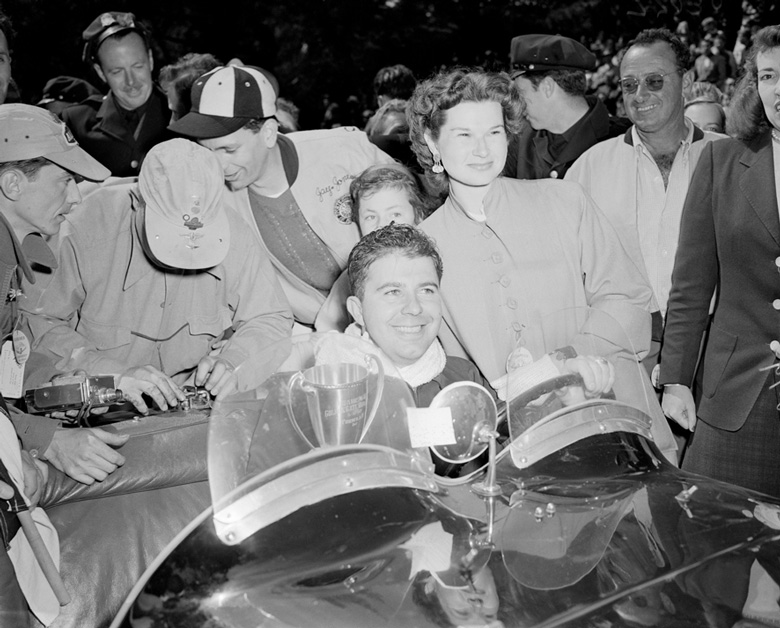
Bill Pollack and his wife Bobbi after winning Golden Gate Park in Carstens’ Allard in 1952. Credit corsa@corsaresearch.com
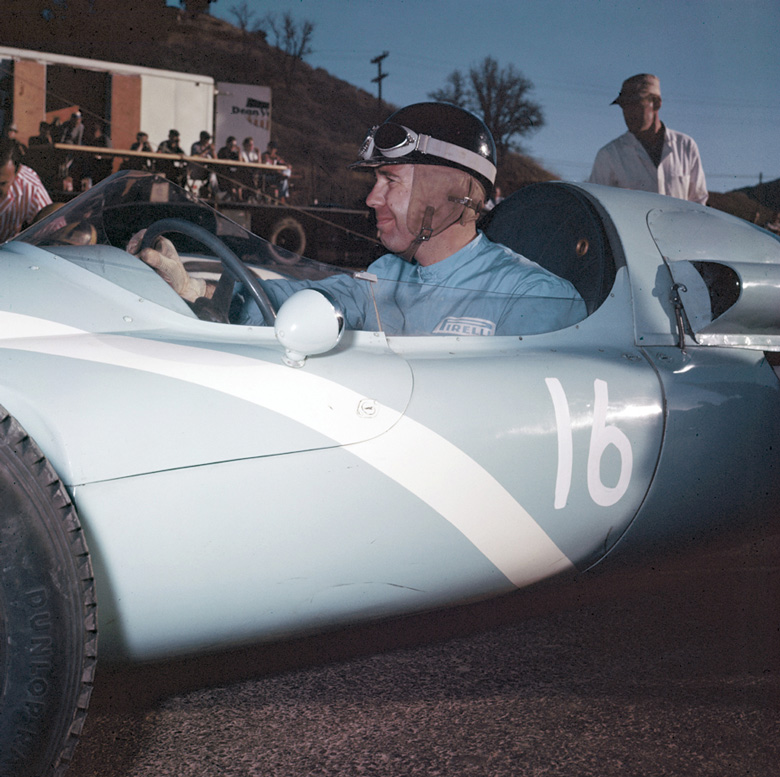
Bill in Lance Reventlow’s FII Cooper Climax at the last Paramount Ranch road race in December 1957. Credit corsa@corsaresearch.com
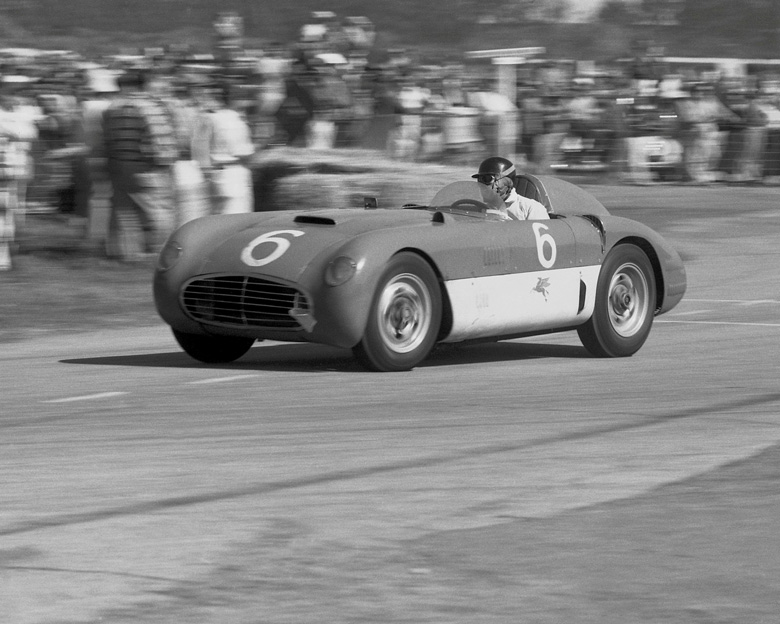
When Bill Pollack drove the well known #6 Bill Murphy Kurtis Kraft 500X Buick at Santa Barbara on May 18 1957 it was a bit long in the tooth for a race car. He came in 12th over-all and 4th in B Modified. Eric Hauser in the equally well know Balchowsky Buick,”Ol’ Yeller” won the event. I those days a photographer pass let you get really up-close and personal with the cars and drivers. Caption and photo by Allen R. Kuhn
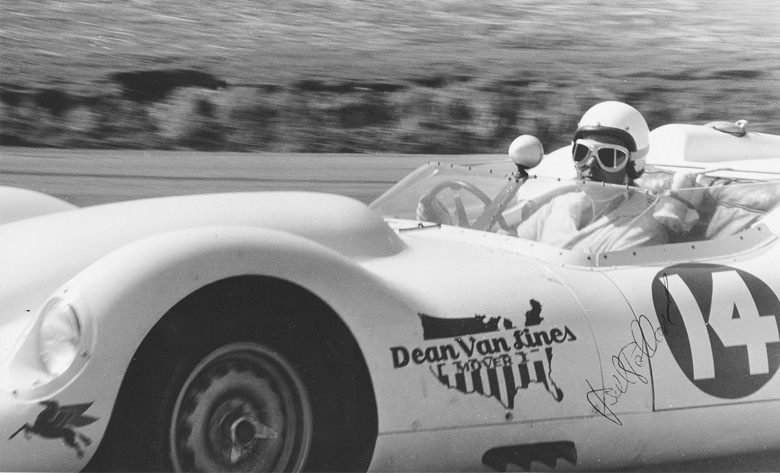
1958 Times GP at Riverside: Bill in the Dean Van Lines Lister/Chevy. It was the last car that Bill raced. Bob Tronolone photo, Willem Oosthoek Collection
If you liked this article, click here to subscribe to VeloceToday!
Well Done all on a subject of one of greats of all time. Bob Devlin
A great feature on a driver that I used to read about in the U.K magazines of the early 1950’s. Quite a character. Nice to see the picture of Bill with Lance Reventlow a very nice young man who I spoke to at Crystal Palace in 1957.
Jimbo Sitz mentioned that “the closest to going pro” for Bill Pollack was Sebring 1957, with the Maserati 200SI of Lance Reventlow. It was actually in 1958, when Bill ran the Dean Van Lines sponsored Lister/Chevy in the professional Times Grand Prix at Riverside. I will email you a photo taken during that race, which Bill was kind enough to autograph.
Another great one bites the dust.
Bill Pollack agreed to be in my book “They Started in MGs.” In addition to his many other attributes, Bill wrote and spoke in a very colorful, very interesting way. Commenting on The Maestro’s test drive of the Corvette “Mule” at the 1957 Sebring, he said of Fangio “He had just set the lap record in the Maserati. He got into the car and took off out of the pits like a rocket. He did the first lap so fast that the suits from GM couldn’t believe their stopwatches. He set a time that was 2 or 3 tenths off the record. He got out of the car, thanked them and left.” Thanks again Bill. I’ll see you later — or at least I hope I will.
I have a soft spot for Allards being from England originally.
My father was going to buy one of their sedans in the early fifties, but had to wait too long. Pity.
I had heard of the Caddy Allards, but didn’t know how well they had performed in the US. Beat Phil Hill, Jaguar and Ferrari. Magic for a machine from a very small car producer in then hands of an expert driver.